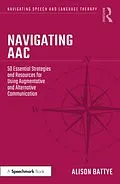Speech and Language Therapists are assumed to have a knowledge of AAC (Augmentative and Alternative Communication). The reality is that, unless they have had a student clinical placement in this field, they will qualify with very little experience in this area.
This book is an approachable guide to AAC and covers the various types, including paper-based and voice-output communication aids. There is guidance on how to assess a person who might need AAC, and how to work collaboratively with those who support the person on a daily basis. The author discusses the importance of core vocabulary alongside a personalised vocabulary. There are pointers for referring to specialised services, signposting families to alternative sources of funding, and making a business case for buying AAC equipment.
Written by an expert in the field, this book provides tips and strategies for SLTs who are brand new to AAC, as well as experienced clinicians wanting to gain further confidence in working with this varied client group.
Autorentext
Alison Battye is the author of Who's afraid of AAC (Speechmark 2017). She is also a Specialist SLT in AAC and manager of regional specialised AAC service.
Inhalt
Assessing for AAC
- Who Needs AAC?
- How to Introduce the Idea of AAC
- Everyone on Board
- Get to Know the Person
- Assess, Don't Guess!
- The Foundations for AAC
- A Consistent Yes or No
- Assessing for Access Method
- Input Before Output
- Multi-modal Communication
- Modelling AAC to a Child
- Communication Partner Training
- Makaton Signs
- Objects of Reference
- Introducing Symbols for Choice-making
- Symbol Sets
- Communication Boards
- Communication Books
- PECS (Picture Exchange Communication System)
- Visual Supports
- Alphabet Charts
- Partner-Assisted Auditory Scanning
- Eye-Pointing Boards and E-Tran Frames
- Single Message VOCAs
- Multiple Message VOCAs
- AAC Apps
- Computer and Tablet VOCAs
- Eye-Gaze Technology
- Message Banking and Voice Banking
- Communication Passports
- Core and Fringe Vocabulary
- Personalising the Vocabulary
- Building Vocabulary Skills
- Building Phrases and Sentences
- Communication Functions
- Conversation Club
- Symbols or Text?
- Assessing Literacy
- Teaching Literacy
- Access to the Curriculum
- Talking Mats
- The Mental Capacity Act (including making decisions)
- Safeguarding and AAC (including enabling the individual to report a concern)
- Multi-Media and Environmental Controls
- AAC Competencies
- Setting Objectives
- Specialist AAC Assessment
- Other Funding Streams
- A Business Case for Funding AAC Resources
- Continuing Professional Development
Supporting the AAC User
AAC Solutions
Building Language Skills with AAC
Literacy, Learning and AAC
Advocacy and AAC
AAC and Access to the World
Funding for AAC
